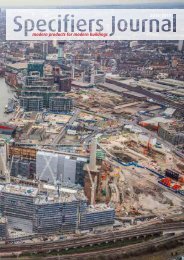ECOBuilder_Specifiers Journal 2018_2019
ECOBuilder_Specifiers Journal 2018_2019
ECOBuilder_Specifiers Journal 2018_2019
Create successful ePaper yourself
Turn your PDF publications into a flip-book with our unique Google optimized e-Paper software.
We all like to work in an environment that is<br />
spacious and flooded in natural daylight and<br />
architects and designers have long appreciated<br />
the benefits of specifying fully glazed<br />
partitions and doors as a way of creating<br />
the ideal workplace for the wellbeing of the<br />
occupants. Since the concept of ‘frameless’<br />
glazing was first embraced, Optima has been<br />
at the vanguard of cutting edge design in low<br />
visual impact glazing systems for commercial<br />
and public sector fit-out.<br />
At Optima the emphasis has always been<br />
on going the extra mile and simply creating<br />
frameless glazing systems is only part of the<br />
journey. We have always believed that glazing<br />
systems should not only look good but must be<br />
capable of delivering exceptional performance<br />
in terms of stability and acoustic privacy. Our<br />
highly skilled design teams are constantly<br />
striving for improvements to our renowned<br />
product range with market-leading acoustic<br />
capability.<br />
So the practice of using glazed systems<br />
for high quality fit-outs is well established,<br />
but that is not necessarily the case where<br />
fire resistance performance is also desired.<br />
Compartmentation and protection of safe<br />
routes has always been seen as the preserve<br />
of solid walls and timber doors but advances<br />
in glass technology has meant that architects<br />
and designers are increasingly looking to<br />
incorporate the openness of glass into their fire<br />
resistant requirements.<br />
Optima’s Technishield range of doors and<br />
partition systems offers complete coverage,<br />
from glazed doors providing 30 minutes<br />
integrity only fire resistance to glazed partitions<br />
offering up to 2 hours integrity and insulation<br />
protection.<br />
But of course it’s not that simple. Recent tragic<br />
events have brought the use of fire resistant<br />
construction products sharply into focus and<br />
their use needs to be carefully and responsibly<br />
managed. It is not just a case of replacing<br />
an area of solid wall construction with fire<br />
resistant glazing. A solid wall will typically span<br />
between structural floors providing a complete<br />
fire barrier. Glazing, on the other hand, will<br />
typically span between the false ceiling and<br />
the finished floor, often a raised access floor.<br />
It will also not necessarily form the entirety of<br />
the length of the compartmentation. A typical<br />
fire resistant glazed partition will span between<br />
two areas of solid wall.<br />
This is where the use of glazing needs to be<br />
carefully managed. The zones above and below<br />
the glazing must be independently fire rated to at<br />
least an equivalent standard and the interfaces<br />
between the zones of protection must satisfy<br />
the requirements of the respective system fire<br />
certifications. The weight of the glazing needs<br />
to be taken into account. A section of glazing 3<br />
metres high and offering<br />
60 minutes integrity and<br />
insulation protection<br />
could weigh in excess of<br />
200kg per linear metre.<br />
The floor construction<br />
must be capable of<br />
supporting that kind of<br />
load under fire conditions.<br />
The same is true with<br />
vertical abutments and<br />
the wall construction<br />
must be compatible with<br />
the tested nature of the<br />
glazing system.<br />
Because we work closely<br />
with glass manufacturers<br />
to ensure the correct glass<br />
product is used in every<br />
instance, the Optima<br />
Technishield range<br />
enables architects and<br />
designers to specify with<br />
confidence and comply with the requirements of<br />
Approved Document B (AD B).<br />
So much for AD B. But what about Approved<br />
Document M (AD M)? Whilst it is possible to<br />
incorporate glazed fire doors into large areas<br />
of fire resistant glazing, their primary function<br />
is to act as a fire barrier when required to do<br />
so and that means that it must be capable of<br />
being closed, without manual intervention,<br />
when there is a fire.<br />
However they are still<br />
required to satisfy<br />
AD M wherever they<br />
are intended to offer<br />
freedom of movement<br />
around the building<br />
and this is particularly<br />
important where doors<br />
are introduced on heavy<br />
circulation routes within<br />
compartment walls or<br />
partitions providing<br />
compartmentation.<br />
Not only are glazed<br />
fire doors heavy but<br />
they will be installed<br />
with a self-closing<br />
device like an overhead<br />
closer. This means<br />
that they can require<br />
an operating force to open them in excess of<br />
the acceptable level stipulated in AD M. Many<br />
sprung door closing devices will rightly claim<br />
that they can comply with AD M but it should<br />
be noted that this is only possible under certain<br />
conditions and their use on heavy glazed fire<br />
doors will fall outside those conditions.<br />
The needs of a fire door to self-close can also<br />
be hindered by ambient conditions. If there is a<br />
significant disparity in air flow on opposite sides<br />
of the door it can often require a closing device<br />
to be increased in its closing force to ensure the<br />
door shuts securely. This further hampers the<br />
operability of the door in normal use.<br />
AD M is very clear on the subject. In stating<br />
its preference for there to be no doors at all,<br />
it recognises that doors are often necessary<br />
and with particular emphasis on fire doors,<br />
it recommends that they either be held<br />
open and released only in the event of fire,<br />
or provided with an automated means of<br />
assisted opening. This needs to be considered<br />
as early as possible in the design process.<br />
It’s far easier to budget for, and incorporate<br />
compliance with AD M at the start of the<br />
process than to re-visit the issue at the end<br />
of the project.<br />
Continuing the theme of fire doors on<br />
circulation routes, these are often required to<br />
include some form of access control. Again<br />
this needs to be carefully considered as not<br />
all systems are compatible with glazed fire<br />
doors.<br />
There’s no denying that this is a very complex<br />
subject but at Optima we go to great lengths<br />
to ensure we understand the issues and can<br />
offer solutions to them. So let us help you<br />
to deliver confidence. Talk to the Optima<br />
technical team first.<br />
C<br />
M<br />
Y<br />
CM<br />
MY<br />
CY<br />
CMY<br />
K<br />
Technishield<br />
Fire rated glass systems<br />
Optima’s extensive Technishield range of<br />
fire rated doors and partitions offers complete<br />
coverage, from 30 minutes integrity only fire resistence<br />
to 2 hours integrity and insulation.<br />
Framed or frameless options allow you to create the design you<br />
want without compromising on fire safety.<br />
To talk to us about fire rated solutions to suit your project, get in touch now<br />
T. +44 1494 492600 | E. action@OptimaSystems.com<br />
OptimaSystems.com







